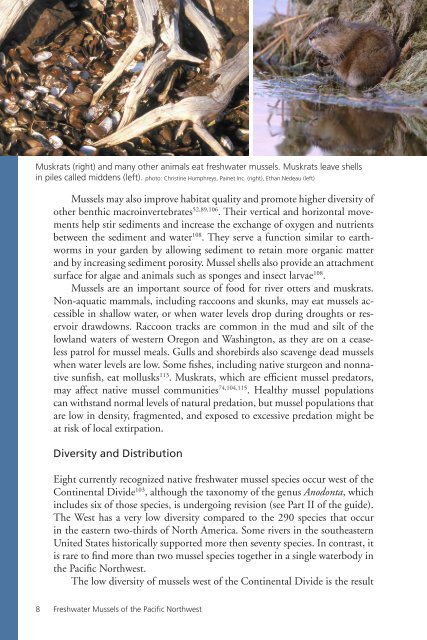Freshwater Mussels Pacific Northwest - The Xerces Society
Freshwater Mussels Pacific Northwest - The Xerces Society
Freshwater Mussels Pacific Northwest - The Xerces Society
You also want an ePaper? Increase the reach of your titles
YUMPU automatically turns print PDFs into web optimized ePapers that Google loves.
Muskrats (right) and many other animals eat freshwater mussels. Muskrats leave shells<br />
in piles called middens (left). photo: Christine Humphreys, Painet Inc. (right), Ethan Nedeau (left)<br />
8<br />
<strong>Mussels</strong> may also improve habitat quality and promote higher diversity of<br />
other benthic macroinvertebrates 52,89,106 . <strong>The</strong>ir vertical and horizontal movements<br />
help stir sediments and increase the exchange of oxygen and nutrients<br />
between the sediment and water 108 . <strong>The</strong>y serve a function similar to earthworms<br />
in your garden by allowing sediment to retain more organic matter<br />
and by increasing sediment porosity. Mussel shells also provide an attachment<br />
surface for algae and animals such as sponges and insect larvae 108 .<br />
<strong>Mussels</strong> are an important source of food for river otters and muskrats.<br />
Non-aquatic mammals, including raccoons and skunks, may eat mussels accessible<br />
in shallow water, or when water levels drop during droughts or reservoir<br />
drawdowns. Raccoon tracks are common in the mud and silt of the<br />
lowland waters of western Oregon and Washington, as they are on a ceaseless<br />
patrol for mussel meals. Gulls and shorebirds also scavenge dead mussels<br />
when water levels are low. Some fishes, including native sturgeon and nonnative<br />
sunfish, eat mollusks 113 . Muskrats, which are efficient mussel predators,<br />
may affect native mussel communities 74,104,115 . Healthy mussel populations<br />
can withstand normal levels of natural predation, but mussel populations that<br />
are low in density, fragmented, and exposed to excessive predation might be<br />
at risk of local extirpation.<br />
Diversity and Distribution<br />
Eight currently recognized native freshwater mussel species occur west of the<br />
Continental Divide 103 , although the taxonomy of the genus Anodonta, which<br />
includes six of those species, is undergoing revision (see Part II of the guide).<br />
<strong>The</strong> West has a very low diversity compared to the 290 species that occur<br />
in the eastern two-thirds of North America. Some rivers in the southeastern<br />
United States historically supported more then seventy species. In contrast, it<br />
is rare to find more than two mussel species together in a single waterbody in<br />
the <strong>Pacific</strong> <strong>Northwest</strong>.<br />
<strong>The</strong> low diversity of mussels west of the Continental Divide is the result<br />
<strong>Freshwater</strong> <strong>Mussels</strong> of the <strong>Pacific</strong> <strong>Northwest</strong>

















